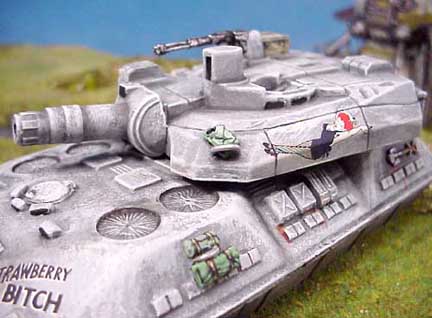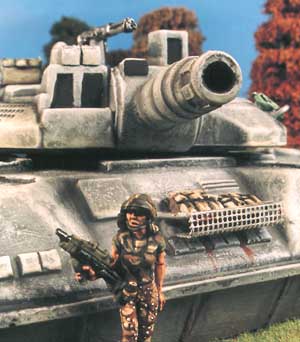Back | Next
Contents
Slammers Artillery
Colonel Hammer's regiment uses only self propelled artillery. They have experimented with (and rejected) calliopes for anti-artillery work (relying on tribarrels and the 20cm powerguns fitted to their M2 Blowers instead) The infantry carry both buzz-bombs – shoulder launched rocket propelled grenades – and grenade launchers for localised bombardment fire. However, the ballistic delivery systems used by the regiment fall into one of three types (only two of which are now currently in service): the L71 10cm mortar mounted in an A21 Jeep, the M18 15cm and the M46 20cm rocket assisted howitzer
Mortars
The semi-automatic, breech loading 10cm L71 mortar (produced by FN of Friesland) is the weapon of choice for the Slammers. This fires from a 4 round clip which is inserted into a hopper mounted above the breech. The weapon can fire all four rounds in under six seconds. A larger weapon from the same manufacturer (the L86) with a more complex breech and a capacious hopper holding two clips (of the same 10cm calibre rounds) was trialed but, ideally, needed to be carried by a larger vehicle or deployed from the vehicle itself in static positions. This did not meet the infantry support requirements of the regiment and so was rejected in favour of the L71.
When in use, the rear seats and cargo area of the jeep is designed to be folded flat to enable one crew member to load and the other to fire the weapon. Tactically, the weapon is often loaded and then fired by one crew member, leaving the driver to move the vehicle as soon as all four rounds are in the air, the objective being avoidance of counter battery fire.
Rounds available for the L71 include HE, white phosphorus, self-forging anti-armour, airburst mini-cracker, targeting, illuminating and practice.
15cm Hogs
The M18 15cm rocket assisted howitzer is based on an M6 or – more usually – an M9 combat car chassis. There is little effective difference in performance or use between the two options, the armour package performance is similar because, to make more internal room on the M9, the iridium liner in the fighting compartment is not fitted. The M18/6 is a slightly smaller vehicle than the M18/9 but both have similar internal layout and storage arrangements. The fighting compartment is reduced to just under 1 metre in height and a flat hull top built directly onto that. This holds the turret ring for the 2.2 metre tall turret, manufactured from aluminium and ceramic composites. The turret has two, full height, horizontally split doors at the rear which, when in use, are often left open: the lower as a ramp and the upper as overhead splinter protection. This increases crew comfort and facilitates ammunition replenishment.
Whilst the M18 is an effective system, the 15cm AL22 weapon has an effective range of only 80 kilometres with standard rounds, although this is increased to 95km with the smaller warhead/extra range propellant combination. All shells have an initial rocket motor fuelled by powdered beryllium with an oxidising agent (boron fluoride) but after a short period of time (depending on load this can be anything from 7 to 10 seconds) the rocket cuts off and the ramjet sustainer motor activates.
Rounds available for the M18/6,9 (AL22) are coded with coloured bands around the olive drab casing (with a white booster stage) and include:
Round type
|
Colour bands (number and size)
|
|
Nuclear (often known as "Red Pills")
|
one red, one white
|
|
K3 (gaseous, non persistent nerve agent; some times known as "Bitter Pills" because of the smell left by the nerve agent)
|
two black
|
|
HE
|
one brown, one white
|
|
Solid Targeting
|
one grey, one white
|
|
Incendiary (white Phosphorus and time-fused zirconium pellets)
|
two white
|
|
Illuminating/star shells
|
one green, one white
|
|
SFASAA (self forging, active-seeking, anti-armour)
|
one purple, one white
|
|
Cluster munitions ("firecrackers")
|
one blue, one white
|
|
Practice
|
one pink, one white
|
|
Practice, extended range
|
one pink, one black
|
|
SFASAA (self forging [depleted uranium], active-seeking, anti-armour), Extended range
|
one purple, one black
|
|
HE, extended range
|
one brown, one black
|
|
Solid targeting, extended range
|
one grey, one black
|
|
Flechette
|
one thick orange
|
|
AFPFDS
|
one thick blue
|
These latter two rounds are designed for anti-personnel and anti-armour direct fire deployment respectively. They are rarely employed and used very much as a 'last resort'.
Shells weigh between 80kg (K3) and 110kg (solid targeting) and the ready drum of ammunition can be discharged within 20 seconds. Crew for both the M18/6 and M18/9 is six (including two drivers) but not all can be carried in the vehicle itself. Two crew ride in the turret with a driver in the M18's front compartment, and three more (two and a driver) in a support vehicle (usually an M9A4C). Although 10 rounds are carried on the primary vehicle in a ready drum, with 10 more stored in the turret, and a further 20 in the support M9, ammunition haulers are used to support the M18 on the move. Often M5's or similar, these can carry over 120 rounds plus vehicle and weapon spares and are equipped with loading conveyer belts to assist the crew.
The M18 and its variants have now been superseded in use in the Slammers by the M46, although the weapon is widely used elsewhere.
20cm Hogs
The M46 is in use with a few standing armies and mercenary units. It is over all a rather larger vehicle than the M18 as it uses a lighter variant of the M1 tank hull as its 'donor' vehicle. Some of the M46's are new builds but many are conversions from refurbished M1 chassis'. The M1 is well suited to this kind of role because of its flexible, modular construction. The M46 has four fans removed from the basic hull, reducing the number to four and the space afforded by this change in running gear is put to good use with crew seating and ammunition storage. The rear hull is reduced to just under 0.5 metres in height and a large turret ring for the spacious 2.5 metre tall turret sits upon that. Manufactured from aluminium and ceramic composites, the turret gives protection from shell splinters and small arms fire to its crew.
 Fig. 6. Icarus Industries M46 20cm "hog" "Strawberry bitch" - Rocket Propelled Artillery ACV with infantryman from the Thunderbolt Legion. (Model conversion based on a vehicle by Ground Zero Games, painted by John Treadaway. Figure by Denizen Miniatures, painted by Graham Green and photography John Treadaway, copyright South London Warlords)
Fig. 6. Icarus Industries M46 20cm "hog" "Strawberry bitch" - Rocket Propelled Artillery ACV with infantryman from the Thunderbolt Legion. (Model conversion based on a vehicle by Ground Zero Games, painted by John Treadaway. Figure by Denizen Miniatures, painted by Graham Green and photography John Treadaway, copyright South London Warlords)
The gun requires eight persons in total, all of whom can be accommodated on the move in either the turret (with some discomfort) or six in the turret and the last two in a pair of seats up front, next to the driver. The turret has two, full height, horizontally split doors at the rear which, like the M18, when in use are left open with the lower door as a ramp and the upper as overhead armour.
 Fig.7. Icarus Industries M46 20cm "hog" "Strawberry bitch" - Rocket Propelled Artillery ACV. (Model conversion based on a vehicle by Ground Zero Games, painted and photographed by John Treadaway, copyright South London Warlords)
Fig.7. Icarus Industries M46 20cm "hog" "Strawberry bitch" - Rocket Propelled Artillery ACV. (Model conversion based on a vehicle by Ground Zero Games, painted and photographed by John Treadaway, copyright South London Warlords)
Combat weight, depending on model, armour packages and ammunition stowage, can vary between 40 and 60 tonnes and manoeuvring ability and cross country performance is only slightly degraded from the other "blower" vehicles it accompanies; this is due more to having a higher centre of gravity than because of any particular degradation of power to weight ratio.
The AL27 20cm weapon mounted on the M46 chassis uses a similar technology to the smaller, 15cm AL22. Ammunition is kept in a 6 round ready drum that can be emptied in 15 seconds. Sustained fire rates are around ten rounds per minute.
The effective range is 130 kilometres with standard rounds, increasing to 170km with the extended range driver motors (with a commensurate loss of warhead mass). All shells have the same type of rocket motor fuelled by powdered beryllium and ramjet sustainer combination as the AL22. Velocity is around 880m per second depending on warhead type.
Rounds available for the AL 27 are similar to the AL22 but significantly larger, weighing between 110kg (K3) and 180kg (solid targeting). AL27 20cm rounds have the same colour markings as the 15cm rounds with two additions.
Round type
|
Colour bands
|
|
LOLDCOM (low orbit, limited duration, communication packages of satellite clusters, known as "Constellation")
|
two silver
|
|
LOR (a limited duration, low orbiting reconnaissance satellite)
|
two gold
|
Both of these rounds lack the ramjet sustainers but are completely rocket powered in two separate stages. They can inject their payloads into orbits of between 25 and 45 kilometers, depending on atmosphere densities and other combat related factors (anticipated life-span, low observability requirements etc).
22 rounds are carried on the M46 hull. Accompanying M5 (or similar) support vehicles carry 80 rounds plus vehicle and weapon spares.
The M46, in various configurations, has superseded the M18 in service with Hammer's Slammers.
Developments
There has been some development of a 'hardened' or 'combat ready' version of an artillery piece by Icarus Industries. Based on an M2 chassis, with full armour suite and a lower, more heavily armoured turret than its contemporaries, this has been designed to operate at the combat front line.
The weapon mounts an AL27 20cm weapon and a cupola mounted 2cm tribarrel for defence, plus a full ADS package. Its major disadvantages in trials seem to centre around a lack of crew and ammunition space. Three crew – driver, gunner/commander and loader - as dictated by the available space and configuration, fire the weapon. It is reloaded from a ready magazine under the turret that holds only 19 rounds. Replenishment requires a team of 6 extra crew in a support vehicle (an M5) with another 44 rounds and enough 'non-combat down time' time to load the magazine through the rear of the turret. So far no one has actually found a combat requirement for this vehicle – initially named the M2-20C – and then purchase some.
Back | Next
Contents
Framed

